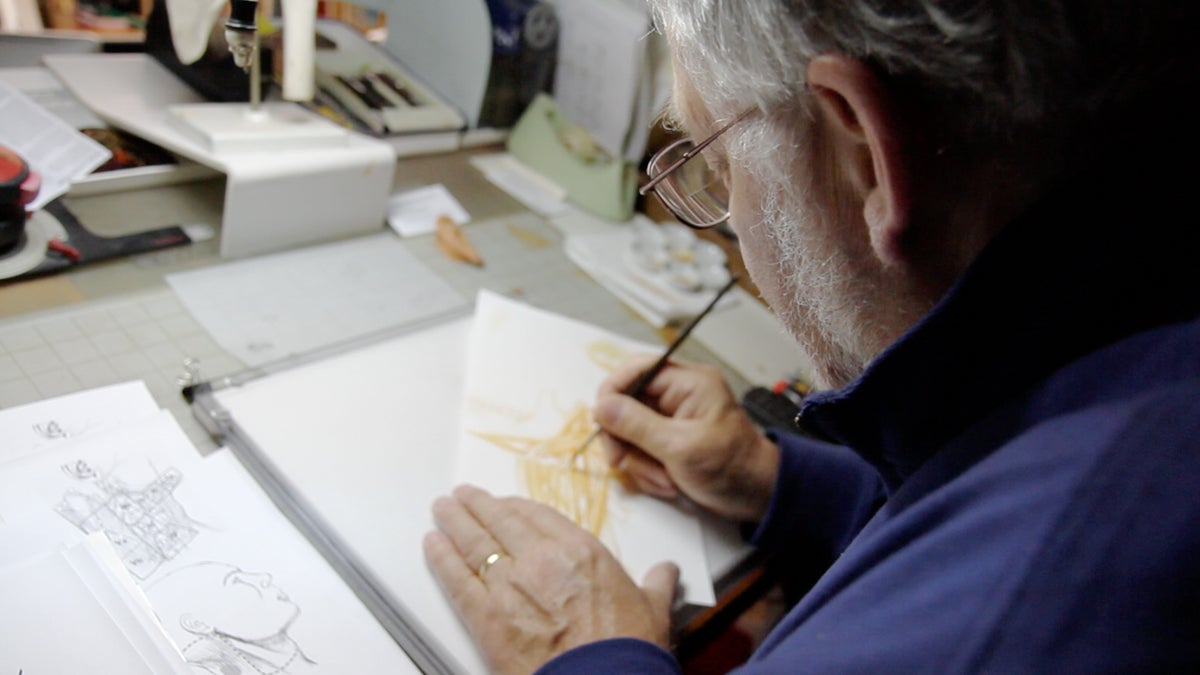Inside the world of medical illustration with Mt. Airy artist Birck Cox
Listen
Medical Illustrator Birck Cox at work in his basement studio in Mt. Airy. (Todd Vachon/WHYY)
We visit a medical illustrator’s studio, where boxes of bones, skulls and anatomy textbooks come to life through paint strokes and computer clicks.
Medical illustrations in textbooks and journals have been teaching doctors about the inside of the human body for centuries.
Now, much of the work is done solely with computers. One Mt. Airy medical illustrator, Birck Cox, melds the old and new when he works, using both paintbrush and computer mouse.
“Most people react to the work that I do with ‘Ewww!!’,” says Cox.
But the illustration he’s working on now, a delicate watercolor of the anatomy of the neck, isn’t at all graphic.
“What we’re looking at is the side of a human neck,” he says. “Visible are the ear and the jaw, the mandible.”
The painting is an intricate tangle of muscles and tendons, rendered with careful brushstrokes in a burnt golden color.
“You gotta get good brushes and good paper,” he says while concentrating on his work. “Because a good water color brush can make a line as thin as you want.”
The Mt. Airy studio and ‘bone box’
Cox clutches his tiny paintbrush as he sits at a massive table in his Mt. Airy basement.
His workspace is half drawing table, half computer desk. A jumble of paintbrushes, pencils and erasers sit to his right. A computer and three different printers are across from him. When he is done with this drawing, he will scan it into his computer to add a layer of fine detail and labels it before sending it to his client.
A shelf of anatomy textbooks cover one wall. A skeleton hangs not far away, and another sits crumpled in a box.
“Oh the bones! the bones!,” he says. “That’s the bone box, there’s arm legs feet hands…”
And skulls — Cox specializes in head and neck illustrations.
“The most interesting skull I have is this one, which comes apart, and goes back together…. it’s very handy for doing head and neck work,” he says. “I can display only as much as I want to show of the interior of the skull.”
Stumbling upon a career
Birck Cox fell into medical illustration by accident in his 20s. He was working for a researcher at a scientific institute in Portland, Oregon.
“He needed illustrations and he had a couple on his wall. I took a look at them and said ‘I could do them’ and when I did something to show him as an example, he said ‘ you got the job’
Cox had taken art classes since he was a boy, but when he went to a liberal arts college, his path took a turn.
“I wanted to do something that demanded rigor in academics rather than simply being able to draw,” he says. “So that was why I sort of broke away from where I’d been going from all that time and major in English.”
In Portland he found a career that combined the academic study of anatomy and pathology with drawing. By that point, he had four years of catch-up art and science classes and a masters program ahead of him. He says his passion for drawing kept him going.
“I knew I could do it. I had an interest in science, I liked learning taxonomy, bugs, mammals, whatever, and the drawing part of it was never a problem,” he says. “As long as there was daylight I could keep on drawing.”
‘If you can draw it, you can build it’
More than 30 years later, he’s still drawing. He mostly produces anatomical illustrations for medical journals and textbooks. But he particularly likes something he does less often — working with medical device companies to draw new inventions.
“I found that I like being at the sort of the thin end of the wedge as far as science and development of ideas are concerned,” he says. “I like being part of that whole system.”
Years ago, Cox drew the LAP band — the device now widely used in bariatric surgeries.
“There’s an old saying in engineering and in sculpture, if you can draw it you can build it…. and that’s why they put me to work on it.”
WHYY is your source for fact-based, in-depth journalism and information. As a nonprofit organization, we rely on financial support from readers like you. Please give today.



